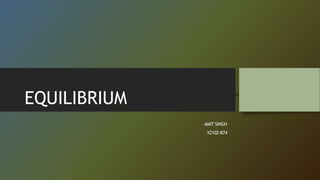equilibriumandlevers-170513135319 (1).pptx
•Als PPTX, PDF herunterladen•
0 gefällt mir•4 views
education
Melden
Teilen
Melden
Teilen

Empfohlen
Weitere ähnliche Inhalte
Ähnlich wie equilibriumandlevers-170513135319 (1).pptx
Ähnlich wie equilibriumandlevers-170513135319 (1).pptx (20)
Mehr von Amit4192779
Mehr von Amit4192779 (20)
anorexianervosaandbilumianervosa-180204081323.pptx

anorexianervosaandbilumianervosa-180204081323.pptx
Kürzlich hochgeladen
Mehran University Newsletter is a Quarterly Publication from Public Relations OfficeMehran University Newsletter Vol-X, Issue-I, 2024

Mehran University Newsletter Vol-X, Issue-I, 2024Mehran University of Engineering & Technology, Jamshoro
This presentation was provided by William Mattingly of the Smithsonian Institution, during the third segment of the NISO training series "AI & Prompt Design." Session Three: Beginning Conversations, was held on April 18, 2024.Mattingly "AI & Prompt Design: The Basics of Prompt Design"

Mattingly "AI & Prompt Design: The Basics of Prompt Design"National Information Standards Organization (NISO)
Kürzlich hochgeladen (20)
Presentation by Andreas Schleicher Tackling the School Absenteeism Crisis 30 ...

Presentation by Andreas Schleicher Tackling the School Absenteeism Crisis 30 ...
Measures of Dispersion and Variability: Range, QD, AD and SD

Measures of Dispersion and Variability: Range, QD, AD and SD
Seal of Good Local Governance (SGLG) 2024Final.pptx

Seal of Good Local Governance (SGLG) 2024Final.pptx
This PowerPoint helps students to consider the concept of infinity.

This PowerPoint helps students to consider the concept of infinity.
Ecological Succession. ( ECOSYSTEM, B. Pharmacy, 1st Year, Sem-II, Environmen...

Ecological Succession. ( ECOSYSTEM, B. Pharmacy, 1st Year, Sem-II, Environmen...
Mixin Classes in Odoo 17 How to Extend Models Using Mixin Classes

Mixin Classes in Odoo 17 How to Extend Models Using Mixin Classes
SECOND SEMESTER TOPIC COVERAGE SY 2023-2024 Trends, Networks, and Critical Th...

SECOND SEMESTER TOPIC COVERAGE SY 2023-2024 Trends, Networks, and Critical Th...
Beyond the EU: DORA and NIS 2 Directive's Global Impact

Beyond the EU: DORA and NIS 2 Directive's Global Impact
Mattingly "AI & Prompt Design: The Basics of Prompt Design"

Mattingly "AI & Prompt Design: The Basics of Prompt Design"
equilibriumandlevers-170513135319 (1).pptx
- 2. Definition of Equilibrium Equilibrium is the condition of a system when neither its state of motion nor its internal energy state tends to change with time.
- 3. Definition of Equilibrium A simple mechanical body is said to be in equilibrium if it experiences neither linear acceleration nor angular acceleration; unless it is disturbed by an outside force, it will continue in that condition indefinitely. For a single particle, equilibrium arises if the vector sum of all forces acting upon the particle is zero.
- 4. Terms associated with Equilibrium •A Force is a push or a pull. •Net Force is the combination of all forces acting on an object. •Tension is the stretching force (springs, rubber bands, etc.) The stretched spring is under the "stretching force” called tension. •Support force is the upward force that acts opposite the force of gravity. •Weight is force of gravity pulling on the mass of an object. •Vector is an arrow that represents the magnitude and direction of a quantity.
- 5. Applications of Equilibrium •Luggage compartment of tour bus is located at the bottom of the bus and not at the roof. •Passengers are not allowed to travel while standing on the upper part of the double decker bus. •Seesaw •Tug of war •Paddling the boat •Support in oil ring
- 7. Types of Equilibrium Stable Equilibrium A body is said to be in stable equilibrium if it tends to return to its original position when slightly displaced.
- 8. Types of Equilibrium Examples are: a) a cone resting on its base; b) a racing car with low centre of gravity and wide base; c) a ball or a sphere in the middle of a bowl.
- 9. Types of Equilibrium Unstable Equilibrium A body is said to be in an unstable equilibrium if when slightly displaced, it tends to move further away from its original position.
- 10. Types of Equilibrium Examples are: a) a cone or an egg resting on its apex or pointed end; b) a ball or a sphere resting on an inverted bowl; c) a tight-rope walker.
- 11. Types of Equilibrium Neutral Equilibrium A body is said to be in neutral equilibrium if when slightly displaced, it tends to come to rest in its new position.
- 12. Types of Equilibrium Examples are: a) a cone or cylinder or an egg resting on its side; b) a ball or a sphere on a smooth horizontal table.
- 13. Laws of Equilibrium Newton’s First Law An object at rest or an object in motion at constant speed will remain at rest or at constant speed in the absence of a resultant force.
- 14. Laws of Equilibrium Transitional Equilibrium An object is said to be in Translational Equilibrium if and only if there is no resultant force. This means that the sum of all acting forces is zero.
- 15. Laws of Equilibrium Rotational Equilibrium A body is said to be in rotational equilibrium when the sum of torque is zero. The object in rotational equilibrium will rotate with angular velocity which could be zero.
- 16. THANKYOU…